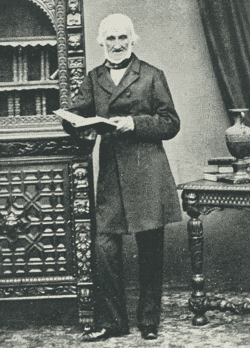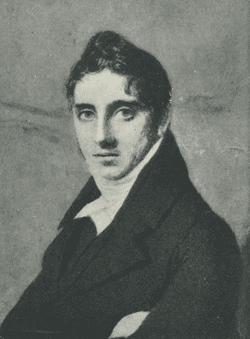George Petrie, Landscape Painter
(b. 1790, d. 1866)
Landscape Painter
From A Dictionary of Irish Artists 1913

George Petrie, P.R.H.A. Photograph, as an old man.
Was born in Dublin on 1st January, 1790, the only child of James Petrie, miniature painter (q.v.), and his wife Elizabeth Simpson, both of Scottish parentage. He received a good education, his father sending him in 1799 to Samuel Whyte's school in Grafton Street, where so many distinguished men were educated. He was intended for the medical profession; but from his childhood he had shown a taste for art, and so he was allowed to follow his inclination to become an artist, and was entered as a pupil in the Dublin Society's drawing school, where he obtained a silver medal for figure drawing in 1805. He assisted his father in his works, but finally devoted himself to landscape painting in water-colours. A portrait of "Lord Manners, Lord Chancellor," by him, probably done at this period, was engraved by Maguire. He made a sketching tour in Wicklow in 1808, and visited Wales in 1810. While in the Dublin Society's school he had formed a friendship with Francis Danby and James A. O'Connor, which lasted through their lives, and in 1813 the three young artists went to London. Petrie spent his time in visiting the private and public collections, and after a short stay returned to Dublin, leaving Danby and O'Connor behind. He continued his work as a landscape painter, and visited Wicklow, Kerry and King's County, and, as a result of his tours, exhibited many views of Dublin and Wicklow scenery, drawings in pen and in water-colour, at the various exhibitions held by the artists of Dublin from 1809 to 1819.
In 1815 he exhibited a "Crucifixion," an altar-piece painted for a Roman Catholic chapel at Kinnegad; and in 1817 a "View of the Bay of Dublin, from Mount Merrion," painted for Sir George Hewitt, Commander of the Forces; "Glenmalure" and "Glendalough," both painted for the Lord Lieutenant, Lord Whitworth, were in the Royal Academy in 1816, the only occasion he exhibited there. The truthfulness and fidelity with which he delineated landscape views and buildings brought his pencil into requisition for book illustrations, and few books of Irish scenery and topography in the first half of the nineteenth century were without engravings from his graceful and delicate drawings. In 1819 he supplied ninety-six illustrations for Cromwell's "Excursions through Ireland"; and he subsequently furnished drawings for the Rev. G. N. Wright's "Guide to Killarney," "Guide to Wicklow," and "Historical Guide to Ancient and Modern Dublin," 1821; for J. J. McGregor's "New Picture of Dublin," 1821, as well as for Brewer's "Beauties of Ireland," 1825; for "Ireland Illustrated," published by Fisher & Co., London, 1831; for "Dublin Delineated," 1831, the "Northern Tourist," and other similar works.

George Petrie, P.R.H.A. Miniature, as a young man, done by James Petrie; in the National Gallery of Ireland.
Petrie began to exhibit at the Royal Hibernian Academy in 1826, the year of its opening exhibition, and contributed almost every year down to 1858. He was elected an Associate on 9th May, 1826, and a Member on the 12th May, 1828. Up to this time no painter who confined himself to work in water-colour had been made a full member, and Petrie was admitted through the influence of T. J. Mulvany, and on the understanding that he was in future to paint in oil as well as water-colour, which, however, he did not carry out.
He was made Librarian in 1829. After 1853 he did not again exhibit until 1858, and his abstention for more than two years was held as a forfeiture of his membership, and the secretary, M. A. Hayes, refused to recognize him as a Member of the Academy, or to summon him to its meetings. A state of confusion then ensued. Petrie was elected President on 26th December, 1856, by one section of the Academy, while Cregan was continued in office by another. The schism continued until the Academy meeting on 17th October, 1857, when Petrie was elected by the general body as President. He, however, retained office for only a short period; for, finding himself in opposition to the views of a large number of his brother Academicians on the subject of the proposed alteration in the constitution of the Academy, he resigned on 7th February, 1859, and on the 21st of the same month was made an Honorary Member.
Petrie's little pencil sketches and his drawings in monochrome, in indian ink or sepia wash, are charming in their truthfulness and delicate execution; but in his water-colours he was far less successful. Though highly esteemed in his time and extravagantly praised by his friends and admirers, who even compared him to Turner, his work was deficient both in colour and execution. His drawings are stiff, with a prevailing bright crome foreground, and hard, blue, distant background, and he showed little knowledge of the technique of his art. His work may be studied in the representative collection in the National Gallery of Ireland, which contains several drawings considered masterpieces in his day, the subjects of extravagant eulogies by his friends. Among these "The Home of the Heron" is described by Dr. Stokes ("Life of Petrie," p. 19) as "perhaps the highest effort of his genius as a landscape painter," and "the delicacy, tenderness and transparency in the painting of the picture, the high imaginative power shown in the treatment of the subject, make it worthy of a place amongst the highest efforts of landscape art in the kingdom."
In his early sketching tours in search of subjects for his pencil the history of the ancient remains, dismantled castles, ruined churches and crosses, excited his curiosity. In 1818, during a tour in the west of Ireland, he visited Clonmacnoise and copied the inscriptions on the inscribed monuments and made drawings of over three hundred of them; and from that time he applied himself to the study of Irish history and antiquities. As early as 1816 he had contributed an article to the "Dublin Examiner" (1st May, 1816) on the "State of the Fine Arts in Ireland," and several other articles from his pen appeared later. In 1828 he was elected a Member of the Royal Irish Academy and was chosen a member of the Council in 1830. He contributed numerous papers to its Transactions, abounding in careful and original investigation, beginning in 1831 with one on "The Autograph Original of the Annals of the Four Masters." For each of his essays "On the Origin and Uses of the Round Towers of Ireland," "On Military Architecture in Ireland," and "On Tara Hill," he was awarded the Academy's gold medal. The essay on the Round Towers, presented to the Academy in 1833, was published as part of his treatise "On the Ecclesiastical Architecture of Ireland"; that "On Tara Hill," intended to accompany the Ordnance Survey Map of the county of Meath, was printed in the "Transactions" of the Academy in 1840. His essay "On the Military Architecture of Ireland" remains unpublished.
As a member of the Council Petrie applied himself, with other members, to the raising of the Academy from the state of torpor in which it then was; to him is largely due the foundation of its museum; and by his efforts many of its most valued treasures were obtained. He lost no opportunity of adding to the library, bringing together a mass of ancient Irish manuscripts which, but for his exertions, would probably have been lost to the country for ever.
Besides his contributions to the "Transactions" of the Academy, twenty-eight in all, Petrie wrote many antiquarian articles for the "Dublin Penny Journal" during its first year, 1832-3; and was afterwards editor of the "Irish Penny Journal," which appeared for a year in 1842.
In 1833 he became connected with the Ordnance Survey of Ireland, being entrusted with the investigation of ancient remains and the drawing up of memoirs containing the descriptions and history of primitive monuments, churches, towns, crosses and monumental stones, and of churches and monasteries. Into this undertaking he threw himself with all his energy and spirit, and gathered roundhim a group of Irish scholars, including O'Donovan and O'Curry, whose labours have done so much for the history, literature and language of ancient Ireland. The first, and unfortunately the only, published memoir appeared in 1837, and related to the portion of the county of Londonderry in the parish of Templemore. Owing to expense the work was then abandoned, and the great mass of material accumulated throughout the country was not used. The staff of workers was dispersed and Petrie ceased his connection with the Survey.
In addition to his life-long labours in the field of Irish archaeology Petrie directed his efforts also to the collection and preservation of old Irish music. Himself a musician, he was able to note down Irish airs as sung or played to him during his journeys. He had begun this work in his youth, and the closing years of his life were devoted to the bringing out of a volume of Irish music, which was published in 1855.
In 1847 he received the degree of LL.D. from the University of Dublin, and he was a member of many learned societies in England and abroad. He was granted a pension on the Civil List in 1849. He died on 17th January, 1866, and was buried on the 22nd in Mount Jerome cemetery, where only a plain stone marks his grave. Dr. Charles Graves, in the "Eloge" delivered by him, as President of the Royal Irish Academy, on 12th February, 1866, thus spoke of Petrie: "His health was always delicate and his temperament sensitive. Thus his total working power was less than that of many other literary men. His intense intellectual energy was out of proportion with his physical strength, and, besides all this, he was intentionally slow in his work, whether with the pencil or the pen, because he was cautious and truthful and in the last degree fastidious. He was unsparing of his labour, and indifferent about reward. Petrie united qualities which are seldom possessed by the same individual; he had the enthusiasm and the imaginative power which are essential to the artist; he also possessed the sagacity and calmness of judgment which are commonly supposed to be characteristic of the man of science. There was in him a singular gracefulness, combined with masculine force. He was sensitive without being morbid; he was playful, but never wayward; he was candid in criticism, but never gave a gratuitous wound to the feelings of an opponent."
A portrait of Petrie, an oil picture, by J. Slattery, is in the Royal Irish Academy in Dawson Street. A miniature portrait, as a young man, done by his father James Petrie, is in the National Gallery of Ireland, where are also a small portrait by B. Mulrenin and a cast from a death-mask. A plaster bust is in the National Museum, Kildare Street.
As a young man Petrie lived with his father at 82 Dame Street, and after his marriage lived for a short time at 5 Essex Quay, removing in 1821 to 21 Great Charles Street, which was his home for many years. In 1850, after the death of his wife, he went to 67 Fortescue Terrace, Rathmines Road, and in 1858 to 7 Charlemont Place. He married in 1819 Eliza Mills, who died on 26th October, 1850. By her he had a son George, who died at the age of 5 years, on 31st October, 1836, and three daughters, Eliza, Mary Anne and Julia. Of these, Mary Anne Petrie painted landscapes in water-colours in the style of her father, and occasionally exhibited in the Royal Hibernian Academy.
« Matthew William Peters | Contents and Search | James Petrie »
